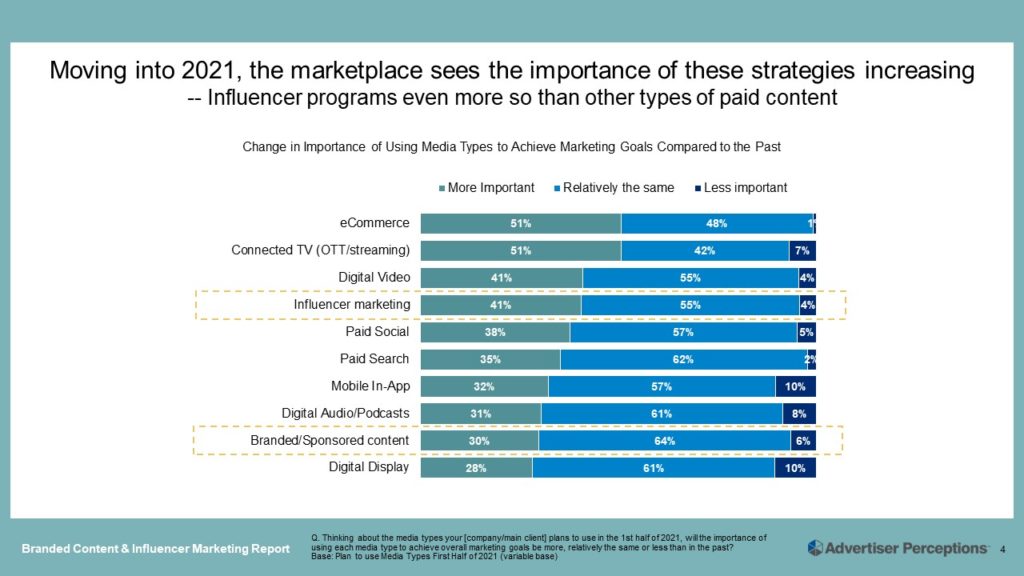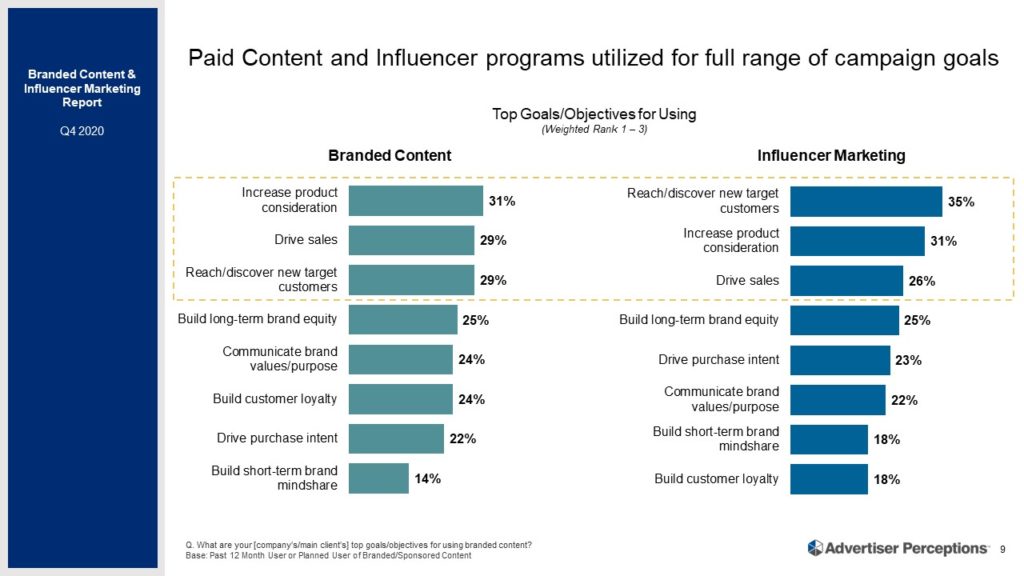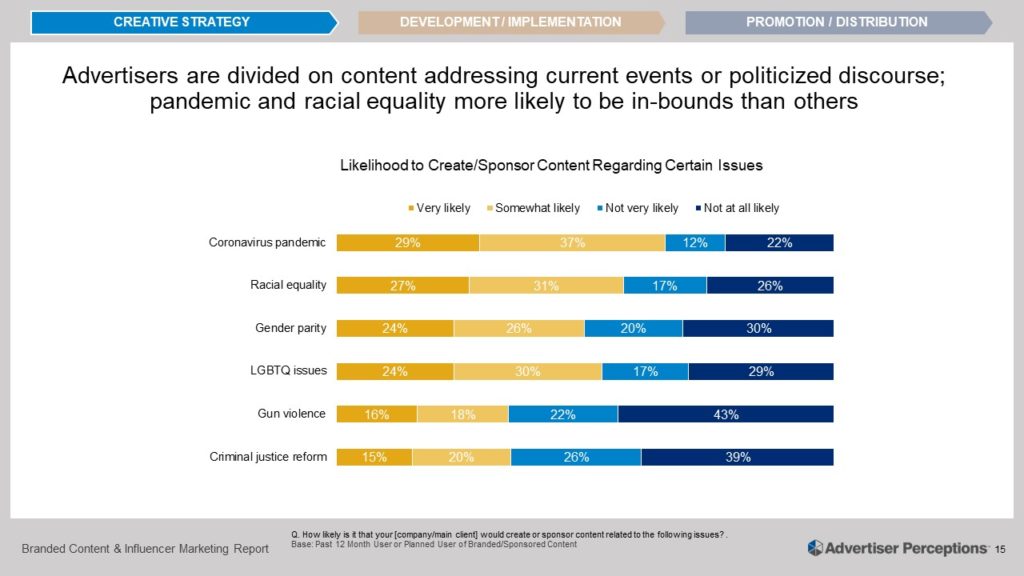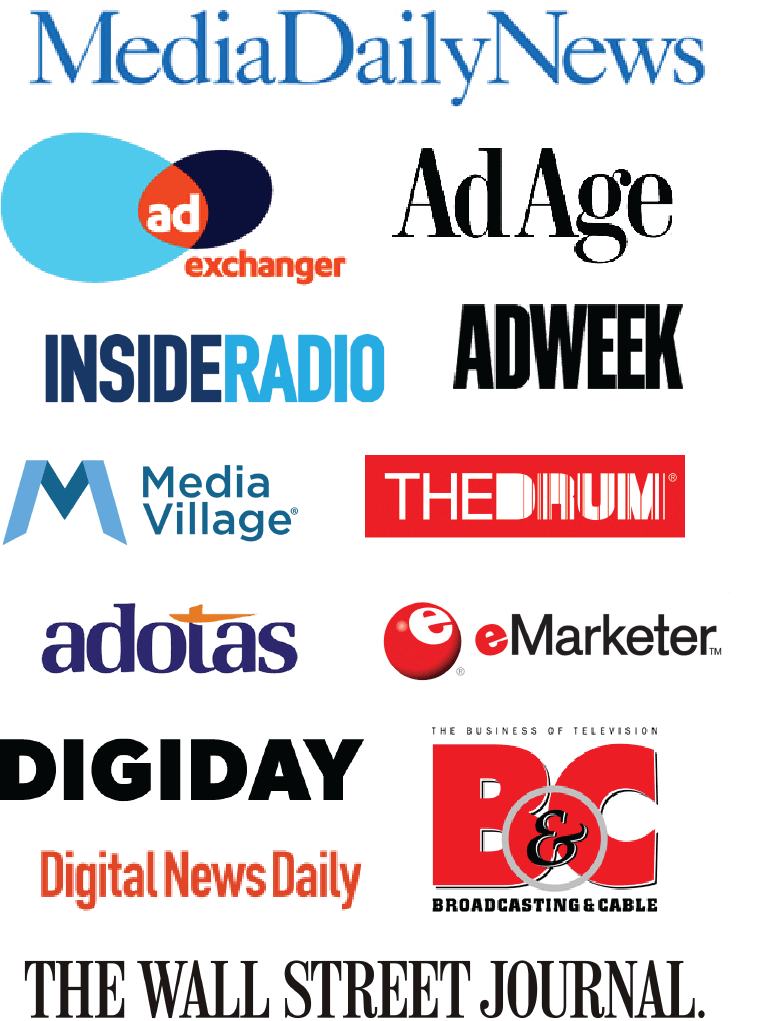New report finds advertisers more bullish on branded content and influencer marketing in more ways, from the ability to address sensitive issues to driving sales.
ACCESS DETAILS ABOUT BRANDED CONTENT AND INFLUENCER MARKETING REPORT HERE
As the pandemic and social justice movement disrupted advertising-as-usual, many sales-driven advertisers elevated their branded content and influencer marketing programs. They’re planning to invest in more forms to cover more marketing objectives, according to Advertiser Perceptions’ Branded Content and Influencer Marketing Report.
More than half of advertisers using paid branded content and influencers say doing so is more critical than it was a year ago. Throughout the second half of 2020, 32% increased spending on branded content and 25% spent more to back influencers. They’re now putting 20% of their digital budgets into the complementary practices, which is more than they put into any other digital channel (paid search is 14%, display 13%, paid social 12%, digital video 12%).
Among those already running branded content or influencer programs, only ecommerce and CTV/OTT have increased in importance to advertisers more than influencer marketing. Four in 10 say influencer marketing has become more important, ahead of paid social, paid search, mobile in-app, digital audio, and branded content – which 30% of advertisers say has become more important.

“Many advertisers returned from lockdowns without their supply systems fully in place, so they had to prioritize upper-funnel activity again,” said Sarah Bolton, EVP/Business Intelligence at Advertiser Perceptions. “Because it seemed insensitive to hard-sell products, they leaned on influencer marketing to drive awareness and humanize their brands.”
Branded content and influencers prove flexible strategies. Advertisers are using branded content and influencers for more reasons, from awareness to driving sales. While advertisers want deeper engagement with their target audiences from both strategies, they look to influencers for audience receptivity and newsworthiness, whereas branded content enables more complex storytelling.
“Advertisers have to move their efforts up and down the funnel unexpectedly – that’s the nature of our world now,” said Bolton. “Branded content and influencer programs let them do that. These resurgent strategies are proving useful for any campaign goal.”

Advertisers willing to approach some “risky” content. Two-thirds of advertisers are willing to sponsor pandemic-related content, and 58% will back racial equality topics. They’re split about 50-50 on gender parity and LGBTQ issues, but most still avoid gun violence and criminal justice reform.

Media are making programs easier to execute. Two-thirds of advertisers say branded and influencer content is easier to execute than it was two years ago. “Influencers and their packages are easier to identify, and pricing is more transparent than it used to be,” said Bolton. “There’s more expertise on what works, and how to leverage an influencer’s assets.”
Big 3 dominate – but here comes Tik Tok. Facebook, Instagram and YouTube are the top venues, with short-form video the first choice, for both branded and influencer content. What’s notable: Tik Tok has already overtaken LinkedIn as an influencer target, as 35% of advertisers short-list Tik Tok vs. 29% for LinkedIn.
Seller’s challenge: it takes a village. Branded content and influencer marketing present a challenge to media sales organizations because most advertisers lack a central team and increasingly more parts of the marketing organization are getting involved.
“Paid content takes a village,” said Bolton. “For media to play successfully in the emerging space, sellers need to coordinate with content, digital, and PR teams, which are aligned differently for each brand. They need to coordinate between creative, digital, media, PR and in-house agencies.”
Media need to integrate brand and influencer content, click to buy. More than one-third of advertisers are prioritizing partners that can put click-to-buy links in their branded and influencer content. Altogether, 80% want shoppable content for influencers, while 74% want it in branded content.
“Media need to bring influencer marketing into their branded content sales,” said Bolton. “An important part of that is shoppable ads. Otherwise, they’re missing out on the areas advertisers are most excited about.”
Advertiser Perceptions interviewed 205 advertisers – 46% marketer, 54% agency – from its proprietary Ad Pros community

